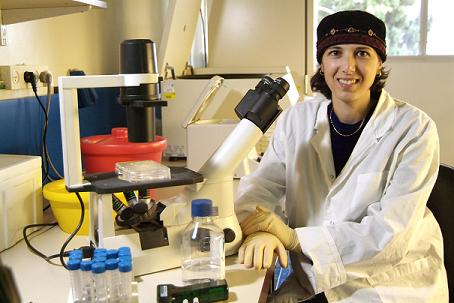Technion Researchers Construct a Polymeric Scaffold Array with Pancreatic Islets Surrounded by a Vascular Network. This heralds the potential for the fabrication of transplantable “islets”.



Technion researchers have succeeded in constructing a three-dimensional polymeric scaffold array with pancreatic islets surrounded by a vascular network, reports the scientific journal PLoS ONE.
“We have shown that the three-dimensional environment and the engineered blood vessels support the islets – and this support is important for the survival of the islets and for their insulin secretion activity”, says Prof. Shulamit Levenberg of the Department of Biomedical Engineering. “We have shown that these laboratory-made polymeric scaffolds can be transplanted subcutaneously and can heal a diabetic mouse. The ability to increase the islets’ vasculature and to support their post-transplant survival could allow the transplant of four times less islets than is customary in transplants in mice, while still achieving decreased blood sugar levels and diabetes relief”.
The mechanism which causes the failure of pancreatic islet transplants is as yet not entirely clear, but the prevailing opinion is that it has to do with ischemic damage – and a delay in the creation of new blood vessels.
The Technion researchers hypothesize that blood vessels also have an active role in inter-cellular communication that supports the survival and function of pancreatic islets. To test this hypothesis, the researchers developed a three-dimensional network of endothelial blood vessels in engineered pancreatic tissues produced from islets, fibroblasts and endothelial cells. This triple array, which was seeded on highly porous polymeric scaffolds, mimics the natural anatomical context of pancreatic vasculature.

“We have shown that the increase in islet survival is correlated with creation of surrounding endothelial tubes”, says Prof. Levenberg. “Adding fibroblasts to pancreatic islet and endothelial cell cultures encouraged the creation of the vascular network, which supported islet survival as well as insulin secretion. Significant differences were seen in many variables – gene expressions, profiles of the growth factors of endothelial cells, ECM, morphogens and screening markers – between two-dimensional culture systems and three-dimensional culture systems that allow an endothelial network, and such differences were even greater after fibroblasts were added that support the creation of the engineered blood vessels.”
Transplanting the vascularized engineered islet tissue has improved the survival and acceptance of such islets in diabetic mice, and has even improved their function in decreasing blood glucose. The Technion researchers hope that these findings herald potential strategies for the fabrication of transplantable islets with improved survivability.
The work was done by research student Keren Francis in Prof. Levenberg’s laboratory and in cooperation with Yuval Dor from the Hebrew university, under a joint research grant provided by Juvenile Diabetes Research Foundation International.
The laboratory is now researching the effect of the vascular network and the three-dimensional growth on human islets, under joint finance of the Juvenile Diabetes Research Foundation International and the Israel Science Foundation.
Published Scientific Paper.
Published Scientific Paper.
| PATENT DETAILS3D vascularized pancreatic islets – for islets transplantation |
| Ref. CTT-0895 |
|
The present invention provides a unique 3D pancreatic-like model for co-culture of isolated pancreatic islets with endothelial cells on a PLLA/PLGA biodegradable polymeric scaffold.
Insulin-dependent diabetes mellitus (IDDM) is a chronic inflammatory disease in which there is autoimmune-mediated organ-specific destruction of insulin-producing beta cells in the pancreatic islets of Langerhans, resulting in glucose homeostasis abnormalities and metabolic complications that are debilitating and life-threatening. Islet transplantation is a potentially curative treatment since replacement of these cells could prevent mortality, however thus far islet cell transplantation has had poor success due mainly to the fact that the tissue grafts must establish new vasculature from the host to survive. Native islets in the pancreas have a rich microvasculature that provides efficient oxygen and nutrient delivery and ensures rapid dispersal of pancreatic hormones to the circulation, and therefore after implantation, the survival and function of islet grafts depends on reestablishment of new blood vessels. During the time required for revascularization, there is a much-increased susceptibility to loss from ischemic injury, so that rapid and adequate islet revascularization is crucial for the survival and function of transplanted islets. In both experimental and clinical islet transplantations, islets are cultured for several days between isolation and transplantation. The present invention provides an advanced tissue-engineering technique for development of 3D co-culture systems that reconstruct vascularization of pancreatic tissue ex-vivo. In this novel engineered 3D pancreatic model, isolated pancreatic islets can be co-cultured with endothelial cells using PLLA/PLGA biodegradable polymeric scaffolds. The endothelial cells organize into 3D tubes throughout the engineered construct and form vascular network-like structures resembling in-vivo vasculature. This presence of endothelial cells forming 3D vessel-like structures was found critical for islet survival. This model can provide an important tool for therapeutic transplantation of islets, greatly increasing the success of the procedure by increasing islet survival and reducing the number of organ donors needed per transplant and the number of repeated transplants, making this procedure more available, biologically and economically. This model also provides new exciting tools for studying central problems in molecular and cell biology of the pancreas. In the U.S, an estimated 20.8 million people (7% of the population) have diabetes mellitus. In the next five years, around US$2.5 billion will be spent worldwide on diabetes mellitus research.
|

